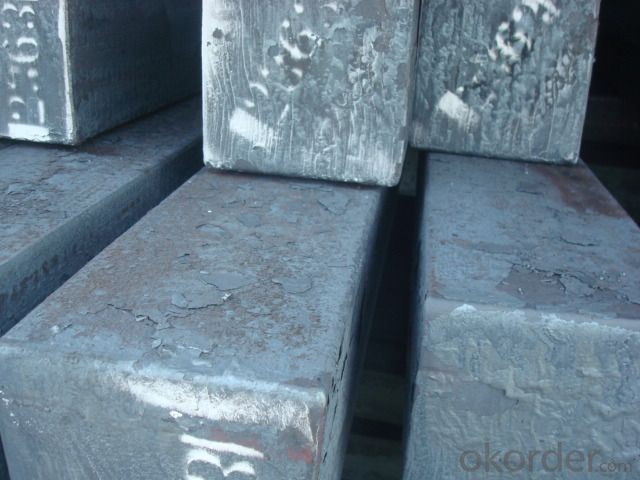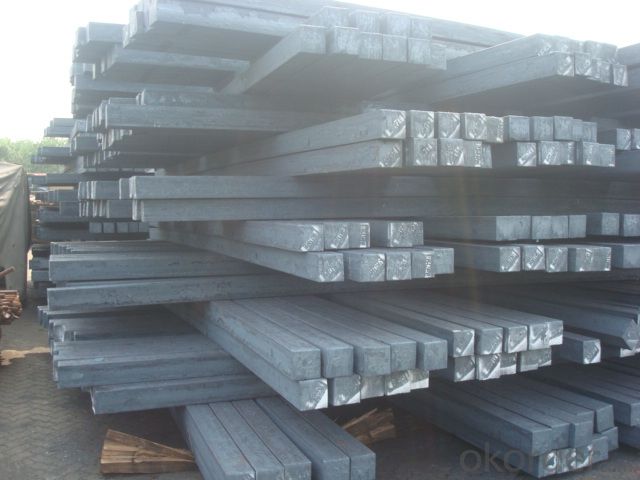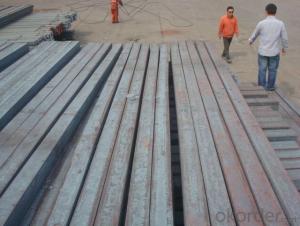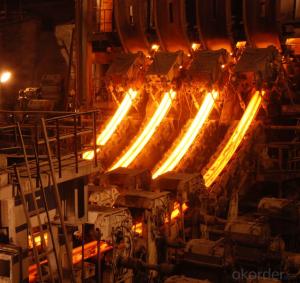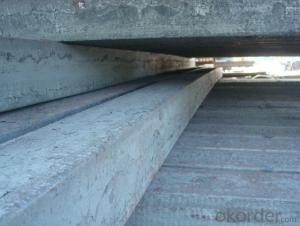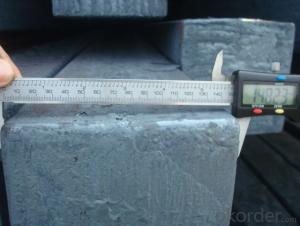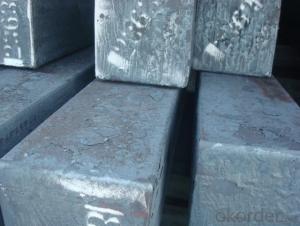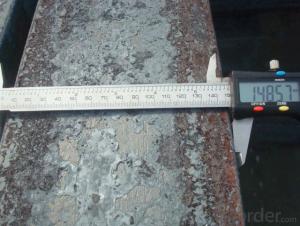Steel Billet Manufactured by Blast Furnace
- Loading Port:
- Tianjin
- Payment Terms:
- TT OR LC
- Min Order Qty:
- 25 m.t.
- Supply Capability:
- 100000 m.t./month
OKorder Service Pledge
OKorder Financial Service
You Might Also Like
Steel Billet Manufactured by Blast Furnace
1.Structure of Steel Billet Manufactured by Blast Furnace
Steel Billet Manufactured by Blast Furnace is the raw material of all kinds of steel mill. Billet section of square, round, flat, rectangular and abnormity, etc Several, mainly related to shape of rolled products. Simple rolled section steel, choose cross section of square billet or rectangular billet. rolling The sector products such as flat steel, Angle steel, select the rectangular billet or slab. Had better profiled billet when production beams, channels, and in rolling process Lines and improve the yield. The raw material of round billet is the production of seamless tube.
2.Main Features of Steel Billet Manufactured by Blast Furnace.
Steel Billet Manufactured by Blast Furnace section size should meet the requirements of rolling deformation and finished product quality, but also roll strength and biting condition of restrictions. General steel Billet section height H. And the roll diameter D The ratio of the ( namely H/D) Should be less than or equal to zero 0.5 . Length of steel billet by finishing temperature, Rolling time and the length of the product Or times ruler. When heated too long accident prone to bump the furnace wall of steel, too short, furnace bottom utilization rate is not high, influence the heating furnace production. For the production Choose a variety of steel and steel billet, should consider the affinities of billet, as far as possible in order to improve the productivity of the roughing mill, simplify the stock management of workshop.
3. Steel Billet Manufactured by Blast Furnace Images
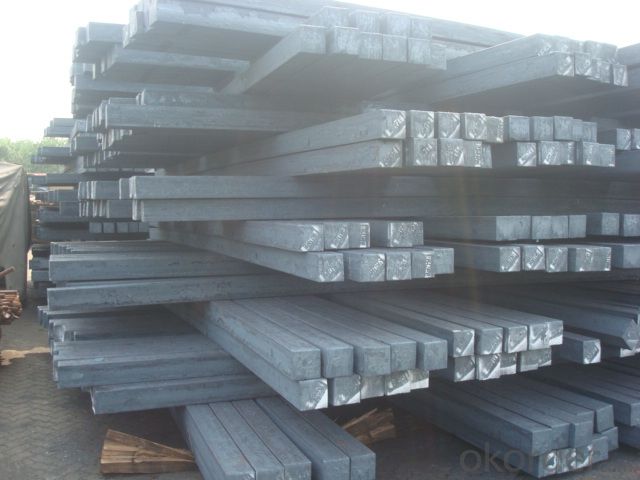
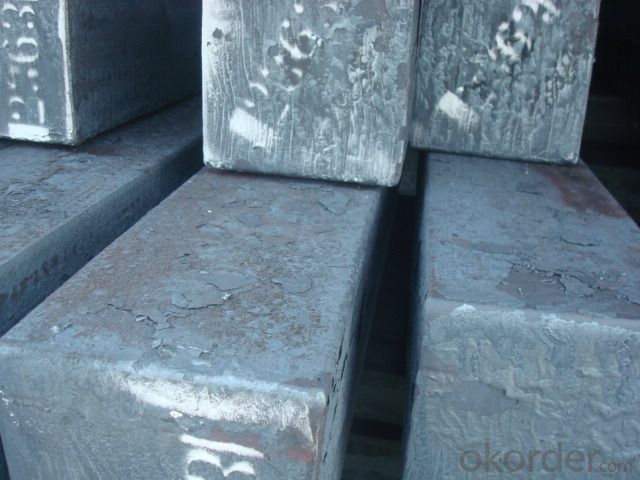
4. Steel Billet Manufactured by Blast Furnace Specification
Steel Billet Manufactured by Blast Furnace rolled steel, after processing can be used for mechanical parts, forging parts, processing all kinds of steel, steel Q345B channel steel, wire rod is the role of the billet. Steel billet is used in the production of semi-finished products, generally cannot be used directly for the society. Steel billets and steel are strictly divided into standard, cannot decide to whether the business enterprise of the final product, and according to unified standards to perform the whole society. Typically, billet and the steel is relatively easy to distinguish, but for some steel billet, and have the same specification and same steel purposes (such as rolling tube billet), whether can be used for other industries, whether through steel processing process, whether through a finished product rolling mill processing to distinguish
Material standard The editor Range of thickness: 150-240 - mm + / - 5 mm width range: 880-1530 - mm + / - 20 mm Length: 3700-10000 - mm + / - 500 - mm Cross-sectional size: 64 * 64; 82 * 82; 98 * 98; 124 * 124; 120 * 150; 152 * 164; 152 * 170 mm Length: 9000 mm Section of tolerance: billet: 1.0 + / - 2.0-1.0 + / - 1.0 mm slab: width: + / - 2.0 mm thickness: + / - 3.0 mm The length tolerance: + / - 200 mm Section diagonal tolerance: 3.5-8.0 MM Billet section size protrusions requirements: < 1242 mm, do not allow; > = 1242 mm, < = 2 mm 1242 mm, < = 3 mm Beheading (shear) extension deformation: < 1242 mm billet: no control; The slab: < = 15 mm Surface tilt: no more than billet section 0.1 Bending: every 1 m length is not more than 10 mm The distortion: length < = 5 m, < = 11. ; The length of the < = 7.5 M, < = 5. Material % 3 sp/PS chemical composition: C Mn Si S P
5.FAQ of Steel Billet Manufactured by Blast Furnace
We have organized several common questions for our clients,may help you sincerely:
①How about your company?
A world class manufacturer & supplier of castings forging in carbon steel and alloy steel,is one of the large-scale professional investment casting production bases in China,consisting of both casting foundry forging and machining factory. Annually more than 8000 tons Precision casting and forging parts are exported to markets in Europe,America and Japan. OEM casting and forging service available according to customer’s requirements.
②How to guarantee the quality of the products?
We have established the international advanced quality management system,every link from raw material to final product we have strict quality test;We resolutely put an end to unqualified products flowing into the market. At the same time, we will provide necessary follow-up service assurance.
③How is the packaging and delivery?
Exporting Package with the steel material cover and the delivery term is based on the project.
- Q: How are steel billets inspected for surface defects?
- Steel billets are inspected for surface defects through visual inspection, magnetic particle inspection, and ultrasonic testing. Visual inspection involves a thorough examination of the surface for any visible defects such as cracks, pits, or rough spots. Magnetic particle inspection uses magnetic particles and a magnetic field to identify any surface or near-surface defects that may not be visible to the naked eye. Ultrasonic testing utilizes high-frequency sound waves to identify internal and surface defects by analyzing the reflected waves. These inspection methods ensure the quality and integrity of steel billets before further processing.
- Q: What are the main factors that affect the competitiveness of steel billets manufacturers?
- There are several factors that significantly affect the competitiveness of steel billets manufacturers. These factors can determine the success or failure of a manufacturer in the highly competitive steel industry. 1. Cost of raw materials: The cost and availability of raw materials, such as iron ore and coal, play a crucial role in determining the competitiveness of steel billets manufacturers. Fluctuations in the prices of these raw materials can impact the overall production costs, and manufacturers need to ensure they have a reliable and cost-effective source of raw materials. 2. Production efficiency: The efficiency of the manufacturing process is another key factor. Manufacturers need to have streamlined production processes and advanced technology to maximize output while minimizing costs. Improving production efficiency can help manufacturers achieve economies of scale, which in turn can enhance competitiveness. 3. Quality control: The quality of steel billets is of utmost importance, as it determines the performance and durability of the final products made from these billets. Manufacturers need to implement stringent quality control measures to ensure that their products meet the required industry standards. Consistently producing high-quality steel billets can give manufacturers a competitive edge. 4. Technological advancements: Keeping up with technological advancements is crucial for manufacturers to stay competitive. Investing in advanced machinery, automation, and digitalization can improve production efficiency, reduce costs, and enhance product quality. Manufacturers need to adopt new technologies and continuously innovate to stay ahead of their competitors. 5. Energy costs: Energy-intensive processes are involved in steel billets manufacturing, and the cost of energy can significantly impact the competitiveness of manufacturers. Access to affordable and reliable energy sources is essential for manufacturers to maintain competitive prices. 6. Market demand and competition: The overall demand for steel billets and the level of competition in the market are significant factors affecting competitiveness. Manufacturers need to have a deep understanding of market trends, customer preferences, and emerging applications to align their production accordingly. Additionally, they must develop a strong marketing strategy to effectively compete with other manufacturers in the industry. 7. Access to skilled labor: The availability of skilled labor is crucial for manufacturers to maintain competitiveness. Skilled workers with expertise in steel production processes can contribute to improved efficiency and quality. Manufacturers need to invest in training programs and attract and retain skilled workers to stay competitive. 8. Government regulations and policies: Government regulations related to environmental compliance, labor laws, and trade policies can impact the competitiveness of steel billets manufacturers. Compliance with these regulations can add to the costs and administrative burden for manufacturers. Adapting to changing regulations and staying in line with industry standards is essential to maintain competitiveness. In conclusion, the competitiveness of steel billets manufacturers is influenced by various factors, including raw material costs, production efficiency, quality control, technological advancements, energy costs, market demand and competition, access to skilled labor, and government regulations. Manufacturers need to address these factors strategically to stay competitive in the ever-evolving steel industry.
- Q: How are steel billets used in the production of rebar?
- Steel billets are used as the primary raw material in the production of rebar. These billets are heated and then passed through a series of rollers to shape them into long, thin rods. The resulting rebar is widely used in construction and infrastructure projects to reinforce concrete structures and provide added strength and durability.
- Q: What are the different types of steel billet rolling mill defects?
- During the rolling process of steel billet in a rolling mill, various types of defects may occur. These defects can impact the final product's quality and performance and can have different causes. Some commonly observed defects include: 1. Surface defects: Scratches, cracks, pits, and scale are visible defects that can occur on the surface of the rolled billet. These defects can be caused by improper handling, insufficient lubrication, or excessive rolling pressures. 2. Shape defects: Deviations from the desired shape of the billet, such as bowing, twisting, or excessive tapering, are referred to as shape defects. Uneven cooling, improper alignment of the rolling mill, or incorrect rolling parameters can cause these defects. 3. Internal defects: Internal defects are not visible on the surface but can impact the structural integrity of the billet. Segregation, porosity, and inclusions are examples of internal defects. The presence of impurities in the raw material, improper heating or cooling, or inadequate quality control measures can cause these defects. 4. Dimensional defects: Deviations from the desired dimensions of the billet, such as variations in length, width, or thickness, are called dimensional defects. Improper calibration of the rolling mill, incorrect rolling parameters, or inadequate quality control measures can cause these defects. 5. Metallurgical defects: Metallurgical defects occur due to improper metallurgical processes during rolling. Grain size variations, improper grain flow, or undesirable microstructure are examples of metallurgical defects. Improper temperature control, inadequate alloying, or insufficient heat treatment can cause these defects. To ensure the production of high-quality steel billets, it is crucial for steel billet rolling mills to implement proper quality control measures. Regular inspections, testing, and monitoring during the rolling process can help identify and rectify these defects, thus minimizing their occurrence.
- Q: How are steel billets recycled at the end of their lifespan?
- At the end of their lifespan, steel billets are recycled through a process known as steel scrap recycling. This involves collecting the steel billets and segregating them from other materials. The billets are then cleaned to remove any contaminants and sorted based on their composition and quality. The next step in the recycling process is to melt the steel billets in a furnace. The high temperatures in the furnace cause the steel to melt, separating it from any impurities. Various techniques, such as electric arc furnaces or basic oxygen furnaces, can be used for this purpose. Once the steel has melted, it is then cast into new billets or other steel products such as bars, rods, or sheets, depending on the desired end product. The molten steel is poured into molds to form the desired shape and then cooled down to solidify. After solidification, the newly formed steel billets are further processed to remove any surface imperfections and give them the desired dimensions. This can involve processes like hot rolling, cold rolling, or heat treatment to enhance the mechanical properties of the steel. The recycled steel billets can then be used in various industries, including construction, automotive, and manufacturing, to produce a wide range of products. By recycling steel billets, the lifespan of the material is extended, reducing the need for virgin steel production and conserving valuable natural resources. Additionally, recycling steel billets helps to reduce energy consumption and greenhouse gas emissions associated with the production of new steel. Overall, the recycling process for steel billets at the end of their lifespan is a crucial component of the circular economy, promoting sustainability and resource efficiency in the steel industry.
- Q: How do steel billets contribute to the fire resistance of a structure?
- The fire resistance of a structure is primarily enhanced by the presence of steel billets, which possess a high melting point and the ability to conduct heat effectively. Unlike wood or concrete, steel has a considerably higher melting point, ranging from 1370 to 1538 degrees Celsius (2500 to 2800 degrees Fahrenheit). The high melting point of steel billets allows them to withstand intense heat without compromising their structural integrity during a fire. Consequently, the steel framework of a building remains intact even when exposed to elevated temperatures, reducing the likelihood of warping, softening, or collapse. Moreover, steel's excellent heat conductivity enables it to rapidly absorb heat and transfer it away from the affected area when exposed to fire. This characteristic prevents the fire from spreading and limits the damage inflicted upon the structure. Additionally, the heat dissipation property of steel helps prevent the transmission of heat to non-steel components like walls or floors, thereby impeding the fire's rapid propagation. Furthermore, steel billets possess a low thermal expansion coefficient, meaning that their expansion rate is comparatively slow when subjected to extreme heat. This attribute prevents excessive movement or deformation of the steel structure during a fire, ensuring the maintenance of stability and structural integrity. In conclusion, steel billets play a vital role in enhancing the fire resistance of a structure by offering high heat resistance, efficient heat conduction, and minimal thermal expansion. These properties render steel an ideal choice for constructing fire-resistant buildings, ensuring increased safety for occupants and reducing the risk of total or partial collapse in the event of a fire.
- Q: How are the surface defects of steel billets repaired?
- Various methods can be employed to repair the surface defects found in steel billets, depending on the type and severity of the defect. Common surface defects include cracks, seams, laps, and scale. One approach to repairing surface defects involves grinding or milling. This entails the utilization of abrasive tools or machines to remove the outer layer of the billet. Grinding can effectively eliminate small defects such as scale, pits, or minor cracks. However, it may not be suitable for extensive or deep defects. For more severe defects like cracks or seams, welding is a common repair technique. The damaged areas are heated to a suitable temperature and then filled using welding electrodes or filler materials. Skilled welders are required to ensure proper fusion and strength of the repaired area. Mechanical methods, such as peening or hammering, can also be employed to repair surface defects. These techniques involve the use of specialized tools to reshape and smooth out the affected areas. Peening can effectively eliminate shallow cracks or surface irregularities. Another method used to identify and repair surface defects in steel billets is ultrasonic testing. This technique utilizes high-frequency sound waves to detect any hidden cracks or flaws. Once the defects are identified, appropriate repair methods can be implemented. It is important to emphasize that the repair process for surface defects in steel billets necessitates careful inspection and assessment to determine the most suitable method. Quality control measures must be implemented to ensure that the repaired billets meet the required standards for strength and integrity.
- Q: Can steel billets be used for making jewelry?
- Yes, steel billets can be used for making jewelry, especially for creating unique and bold designs that incorporate an industrial or contemporary aesthetic. However, steel is not as commonly used for jewelry making compared to other materials like gold, silver, or platinum.
- Q: What are the different types of steel billet casting processes?
- There are several different types of steel billet casting processes, including continuous casting, semi-continuous casting, and ingot casting. Continuous casting involves the continuous pouring of molten steel into a water-cooled mold, allowing for a continuous production process. Semi-continuous casting, on the other hand, involves the periodic pouring of molten steel into individual molds, resulting in intermittent production. Ingot casting is a traditional method where molten steel is poured into a stationary mold, allowing it to solidify into a solid block or ingot shape. These different casting processes offer various advantages and are utilized based on the specific requirements of the steel production industry.
- Q: What are the potential risks associated with steel billet production?
- There are several potential risks associated with steel billet production. One significant risk is the high temperature involved in the process, which can lead to burns and fire hazards if not properly managed. Additionally, the handling of heavy machinery and equipment poses a risk of accidents and injuries to workers. The use of chemicals and hazardous substances in the production process can also pose health risks if not handled safely. Another potential risk is the emission of pollutants and greenhouse gases during production, contributing to environmental concerns. It is crucial for steel billet producers to implement appropriate safety measures, train their employees, and adhere to environmental regulations to mitigate these risks.
Send your message to us
Steel Billet Manufactured by Blast Furnace
- Loading Port:
- Tianjin
- Payment Terms:
- TT OR LC
- Min Order Qty:
- 25 m.t.
- Supply Capability:
- 100000 m.t./month
OKorder Service Pledge
OKorder Financial Service
Similar products
Hot products
Hot Searches
Related keywords


